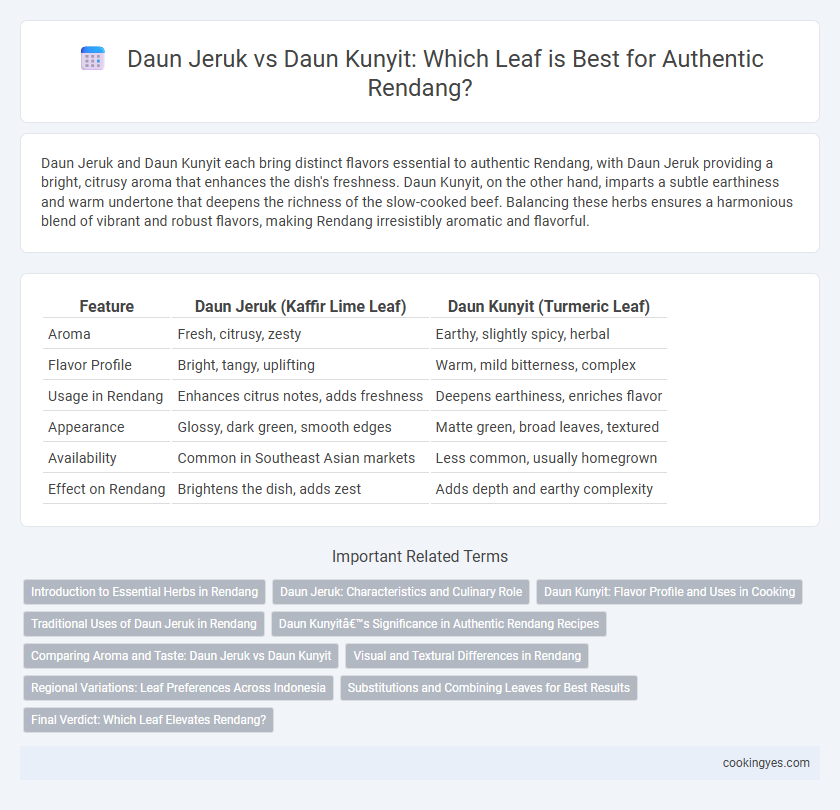Daun Jeruk and Daun Kunyit each bring distinct flavors essential to authentic Rendang, with Daun Jeruk providing a bright, citrusy aroma that enhances the dish's freshness. Daun Kunyit, on the other hand, imparts a subtle earthiness and warm undertone that deepens the richness of the slow-cooked beef. Balancing these herbs ensures a harmonious blend of vibrant and robust flavors, making Rendang irresistibly aromatic and flavorful.
Table of Comparison
| Feature | Daun Jeruk (Kaffir Lime Leaf) | Daun Kunyit (Turmeric Leaf) |
|---|---|---|
| Aroma | Fresh, citrusy, zesty | Earthy, slightly spicy, herbal |
| Flavor Profile | Bright, tangy, uplifting | Warm, mild bitterness, complex |
| Usage in Rendang | Enhances citrus notes, adds freshness | Deepens earthiness, enriches flavor |
| Appearance | Glossy, dark green, smooth edges | Matte green, broad leaves, textured |
| Availability | Common in Southeast Asian markets | Less common, usually homegrown |
| Effect on Rendang | Brightens the dish, adds zest | Adds depth and earthy complexity |
Introduction to Essential Herbs in Rendang
Daun Jeruk and Daun Kunyit are essential herbs that define Rendang's unique flavor profile, with Daun Jeruk adding a citrusy aroma and Daun Kunyit imparting earthy, slightly bitter notes. These herbs contribute to the complex layering of spices and aromas crucial in traditional Minangkabau Rendang recipes. Their inclusion enhances the dish's depth, creating a balance between freshness and warmth critical for authentic Indonesian Rendang.
Daun Jeruk: Characteristics and Culinary Role
Daun Jeruk, also known as kaffir lime leaves, offers a unique citrus aroma and slightly floral flavor that enhances rendang's rich, spicy profile by adding brightness and depth. Its glossy, dark green leaves are typically torn or finely sliced to release essential oils, infusing the dish with a fresh, zesty note that balances the coconut milk and meat's richness. Unlike daun kunyit, which lends a subtle earthy bitterness, daun jeruk's vibrant citrus scent plays a critical role in elevating rendang's complex taste layers.
Daun Kunyit: Flavor Profile and Uses in Cooking
Daun Kunyit, or turmeric leaves, impart a subtle earthy aroma and a slightly bitter, peppery flavor that enhances the complexity of Rendang. Unlike daun jeruk, which adds bright citrus notes, daun kunyit provides a deep herbal undertone that complements the rich, spicy coconut sauce. Its sturdy texture allows it to withstand long cooking times, making it ideal for slow-simmered dishes like traditional Rendang.
Traditional Uses of Daun Jeruk in Rendang
Daun Jeruk, or kaffir lime leaves, are traditionally essential in Rendang for their distinctive citrus aroma that enhances the dish's rich, spicy profile. Unlike daun kunyit (turmeric leaves), which impart an earthy, slightly bitter note, daun jeruk contributes a bright, fragrant freshness that balances the slow-cooked coconut milk and meat. The use of daun jeruk in authentic Minangkabau Rendang recipes is crucial for achieving the signature complex flavor that defines this Indonesian culinary classic.
Daun Kunyit’s Significance in Authentic Rendang Recipes
Daun kunyit (turmeric leaves) play a crucial role in authentic Rendang recipes, imparting a distinct aroma and subtle bitterness that enhances the dish's complex flavor profile. Unlike daun jeruk (kaffir lime leaves), which add a citrusy freshness, daun kunyit contributes earthy, herbal notes essential for the traditional slow-cooked beef Rendang. This unique ingredient helps achieve the signature balance of richness and depth that defines genuine Minangkabau Rendang.
Comparing Aroma and Taste: Daun Jeruk vs Daun Kunyit
Daun Jeruk imparts a bright, citrusy aroma with a slightly tangy taste that enhances the richness of Rendang, offering a fresh contrast to the dish's deep spices. Daun Kunyit provides an earthy, mildly bitter flavor with herbal notes that add depth and complexity to Rendang's savory profile. The choice between Daun Jeruk and Daun Kunyit directly influences the Rendang's aroma and taste, where Daun Jeruk brightens and freshens while Daun Kunyit deepens and enriches the overall flavor.
Visual and Textural Differences in Rendang
Daun jeruk imparts a glossy, vibrant green appearance and a slightly crisp texture to rendang, enhancing its visual appeal and adding subtle citrusy notes. In contrast, daun kunyit contributes a deeper, darker green hue with a softer, more fibrous texture that enriches the dish's earthiness and complexity. The visual distinction between the bright, shiny leaves of daun jeruk and the matte, velvety surface of daun kunyit influences the overall presentation and mouthfeel of authentic rendang.
Regional Variations: Leaf Preferences Across Indonesia
Daun Jeruk and Daun Kunyit are essential aromatic leaves that define regional rendang variations across Indonesia. West Sumatra's Minangkabau rendang typically features Daun Jeruk (kaffir lime leaves) to impart a fresh citrus aroma, while in parts of Padang and Riau, Daun Kunyit (turmeric leaves) is preferred for its earthy, slightly bitter flavor enhancing the dish's complexity. These leaf preferences reflect the diverse culinary practices and local ingredient availability shaping rendang's distinctive regional profiles.
Substitutions and Combining Leaves for Best Results
Daun jeruk (kaffir lime leaves) adds a bright citrus aroma to rendang, while daun kunyit (turmeric leaves) contributes a distinct earthy and slightly peppery flavor. Substituting daun kunyit with daun jeruk can alter the traditional taste, but combining both leaves enhances complexity, balancing vibrant freshness with rich warmth. For best results, use a blend of daun jeruk and daun kunyit to achieve authentic rendang flavors with layered herbal notes.
Final Verdict: Which Leaf Elevates Rendang?
Daun Jeruk imparts a bright, citrusy aroma that enhances Rendang's complex spice profile, while Daun Kunyit offers a subtle earthy flavor and vibrant color. The final verdict favors Daun Jeruk for elevating Rendang with its fresh, zesty notes that balance the rich, slow-cooked coconut and beef flavors. Using Daun Jeruk results in a more fragrant and layered Rendang experience, making it the preferred choice for authentic taste elevation.
Daun Jeruk vs Daun Kunyit for Rendang Infographic

 cookingyes.com
cookingyes.com